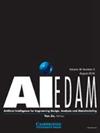无表现的设计
IF 1.7
3区 工程技术
Q3 COMPUTER SCIENCE, ARTIFICIAL INTELLIGENCE
Ai Edam-Artificial Intelligence for Engineering Design Analysis and Manufacturing
Pub Date : 2022-02-09
DOI:10.1017/S0890060421000421
引用次数: 0
摘要
抽象形状被认为是未经分析的,没有对其部分进行严格的表示。它们不符合标准的符号知识表示标准;他们是根据外表来对待和评判的。解决局部与局部、局部与整体的关系在感知和设计中具有建设性作用。本文介绍了设计中零件-整体造型的计算方法。为此,形状规则用于显示如何看待形状,具有拓扑结构和布尔代数结构的形状分解揭示了零件的替代结构。给出了四个形状计算的例子。拓扑在计算中展示了整体、部分和子部分的关系,从而实现了结构的比较和相对化,并使用格图来表示它们的顺序。回顾过去,拓扑结构有助于回忆生成历史并建立计算连续性。当修改零件以局部识别涌现正方形时,随着拓扑结构的重新调整,其他涌现形状将全局高亮显示。确定了两种类型的涌现:本地和全球。看到局部会改变我们分析全局整体的方式,因此,局部观察会产生全局秩序。本文章由计算机程序翻译,如有差异,请以英文原文为准。
Design without representation
Abstract Shapes are perceived unanalyzed, without rigid representation of their parts. They do not comply with standard symbolic knowledge representation criteria; they are treated and judged by appearance. Resolving the relationship of parts to parts and parts to wholes has a constructive role in perception and design. This paper presents a computational account of part–whole figuration in design. To this end, shape rules are used to show how a shape is seen, and shape decompositions having structures of topologies and Boolean algebras reveal alternative structures for parts. Four examples of shape computation are presented. Topologies demonstrate the relationships of wholes, parts, and subparts, in the computations enabling the comparison and relativization of structures, and lattice diagrams are used to present their order. Retrospectively, the topologies help to recall the generative history and establish computational continuity. When the parts are modified to recognize emergent squares locally, other emergent shapes are highlighted globally as the topology is re-adjusted. Two types of emergence are identified: local and global. Seeing the local parts modifies how we analyze the global whole, and thus, a local observation yields a global order.
求助全文
通过发布文献求助,成功后即可免费获取论文全文。
去求助
来源期刊
CiteScore
4.40
自引率
14.30%
发文量
27
审稿时长
>12 weeks
期刊介绍:
The journal publishes original articles about significant AI theory and applications based on the most up-to-date research in all branches and phases of engineering. Suitable topics include: analysis and evaluation; selection; configuration and design; manufacturing and assembly; and concurrent engineering. Specifically, the journal is interested in the use of AI in planning, design, analysis, simulation, qualitative reasoning, spatial reasoning and graphics, manufacturing, assembly, process planning, scheduling, numerical analysis, optimization, distributed systems, multi-agent applications, cooperation, cognitive modeling, learning and creativity. AI EDAM is also interested in original, major applications of state-of-the-art knowledge-based techniques to important engineering problems.

 求助内容:
求助内容: 应助结果提醒方式:
应助结果提醒方式:


